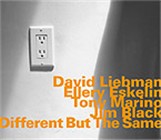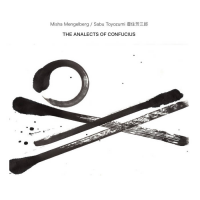Home » Jazz Articles » Album Review » David Liebman / Ellery Eskelin: Different But the Same
David Liebman / Ellery Eskelin: Different But the Same
And so, on Different But the Same, we find two saxophonists converging on a middle ground that somehow incorporates both elements into a surprisingly cogent blend. And while they find common turf, there is no compromise in sight. With each saxophonist bringing along one player with a longstanding association—in Liebman's case it's bassist Tony Marino, who has been a part of Liebman's groups of the past few years; Eskelin brings along the ever-versatile drummer Jim Black, whose shared relationship dates back over a decade—the meeting is certainly democratic. It's fascinating to hear Black in a more traditional arena than his usual, and to find Marino playing with a greater sense of freedom.
With a set containing originals from both, but also reaching back with interpretations of material by Tadd Dameron, Lee Konitz, Wayne Shorter, and Cole Porter, Different But the Same demonstrates that Liebman and Eskelin share far more than they differ. In fact, the two approach the music with such a similar sensibility that, according to Liebman, "I can't always tell the difference myself," with Eskelin indicating that this was "the result of natural musical choices and the joy in speaking a shared language." Fortunately, the recording places Liebman on the left channel and Eskelin on the right, so despite remarkably simpatico approaches, it's not difficult to identify each player.
Even compositionally there are more similarities than differences. Liebman's "The Gun Wars" begins with a furious drum solo from Black, only to be joined by Marino, Liebman, and Eskelin in one of the most extreme segments of free playing of the set, before settling into an out-of-time unison theme that helps provide some form, albeit couched in a purely unstructured rhythmic backdrop. Eskelin's "How Do I Know" is no less outré, but less intense in nature. And Shorter's "Vonetta" is treated with a more open approach than the original.
Dameron's "Gnid," with its more defined pulse and traditional harmonies, is the most mainstream piece of the set, while Liebman's "Tie Those Laces" combines open-ended improvisation with a humorously idiosyncratic theme. Eskelin's "You Call It" revolves around a three-note phrase, but it demonstrates just how far such a simple conceit can be taken.
Rather than being a dichotomous curiosity, Different But the Same instead reveals how even if two players share a common goal, the route each one takes to get there can be very different indeed.
Track Listing
Tie Those Laces; Gnid; You Call It; Different But the Same; What is This Thing: Subconsciousl-Lee, Hot House, What is This Thing Called Love; How Do I Know; Vonetta; The Gun Wars,
Personnel
Dave Liebman
saxophoneDave Liebman: tenor saxophone; Ellery Eskelin: tenor saxophone; Tony Marino: double-bass; Jim Black: drums, percussion.
Album information
Title: Different But the Same | Year Released: 2005 | Record Label: Hat Hut Records
Tags
PREVIOUS / NEXT
Support All About Jazz
 All About Jazz has been a pillar of jazz since 1995, championing it as an art form and, more importantly, supporting the musicians who make it. Our enduring commitment has made "AAJ" one of the most culturally important websites of its kind, read by hundreds of thousands of fans, musicians and industry figures every month.
All About Jazz has been a pillar of jazz since 1995, championing it as an art form and, more importantly, supporting the musicians who make it. Our enduring commitment has made "AAJ" one of the most culturally important websites of its kind, read by hundreds of thousands of fans, musicians and industry figures every month.


















